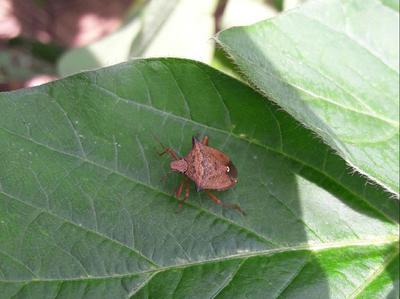Stink Bugs on Soybean
Pentatomidae
Insect
In a Nutshell
- Little apparent damage on leaves or stems.
- Stink bugs feed on pods and seeds during maturation.
- Seeds can be deformed, underdeveloped or aborted.
- Older seeds are discolored.
Can also be found in
Symptoms
An infestation with Stink Bugs can be hard to recognize before harvest. Adults and nymphs attack pods and seeds of soybeans and leave no apparent feeding damage on leaves or stems. At harvest, deformed, underdeveloped or aborted young seeds can be found. The older seeds grow discolored and shriveled. Stink Bugs also feed on other parts of the plant. Small brown or black spots are left in the tissues that were punctured by the insect. Fruit and seed maturation is compromised, and plants may only have few and small pods.
Recommendations

Organic Control
Promote parasitoid flies or wasps to control Stink bugs populations. They lay eggs on the Stink Bugs. Parasitized eggs are typically darker. The larvae of these insects feed on hatching maggots and adults from inside. Predators such a birds and spiders can also reduce infestation. You can also use the oil of Eucalyptus urograndis. It is toxic to the Stink bugs and their nymphs.

Chemical Control
Always consider an integrated approach with preventive measures together with biological treatment if available. Before applying any insecticide, monitor your fields to check critical numbers and species present. If necessary, use products containing pyrethroids to control stink bug populations.
What caused it?
Several species of stink bug attack soybeans. The worst is Acrosternum hilare. Adults are about 1.3 cm long, green-coloured and are their shape resembles a shield. They are called stink bugs because of the foul smell they produce to deter predators. They use their mouthparts to drill into the tender pods and developing seeds, inject digestive substances, and suck the resulting liquids. Nymphs are almost round, wingless and black with red spot on the head. Eggs are barrel-shaped and laid in groups.
Preventive Measures
- Plant early to avoid population peaks of stink bugs.
- Monitor regularly critical number of insects.



